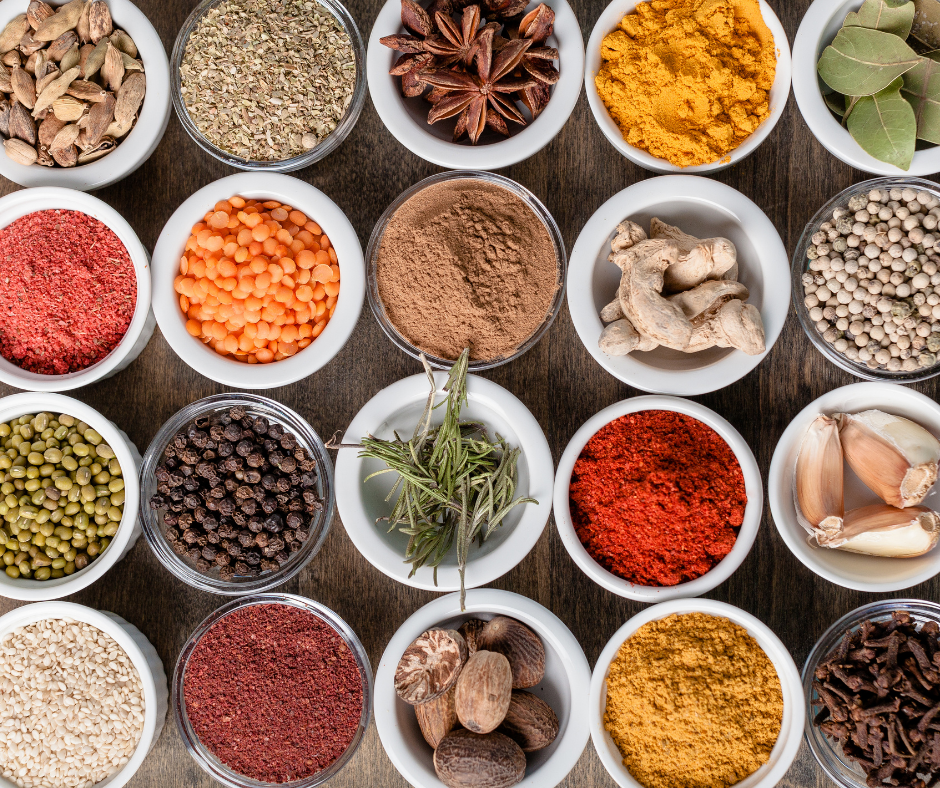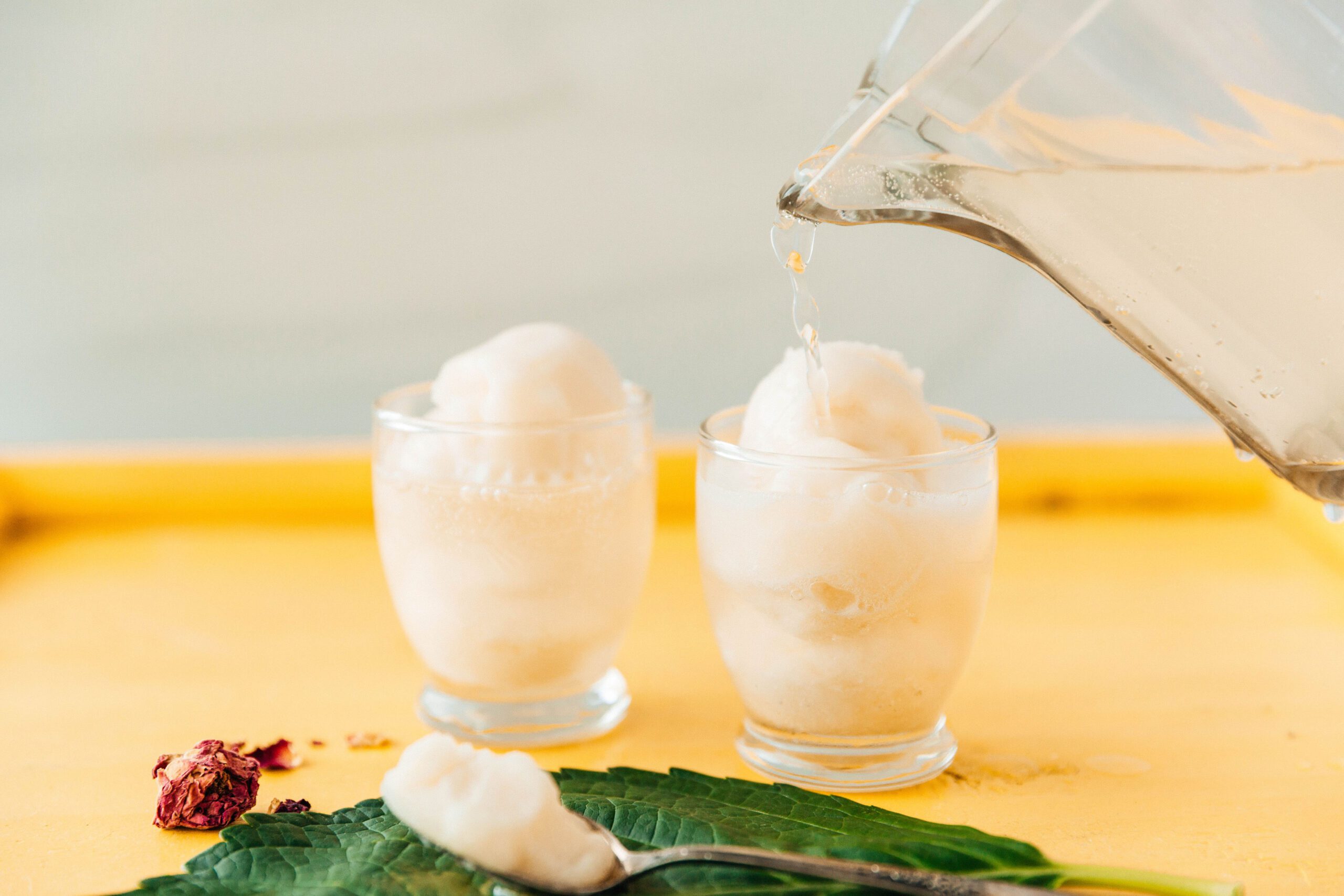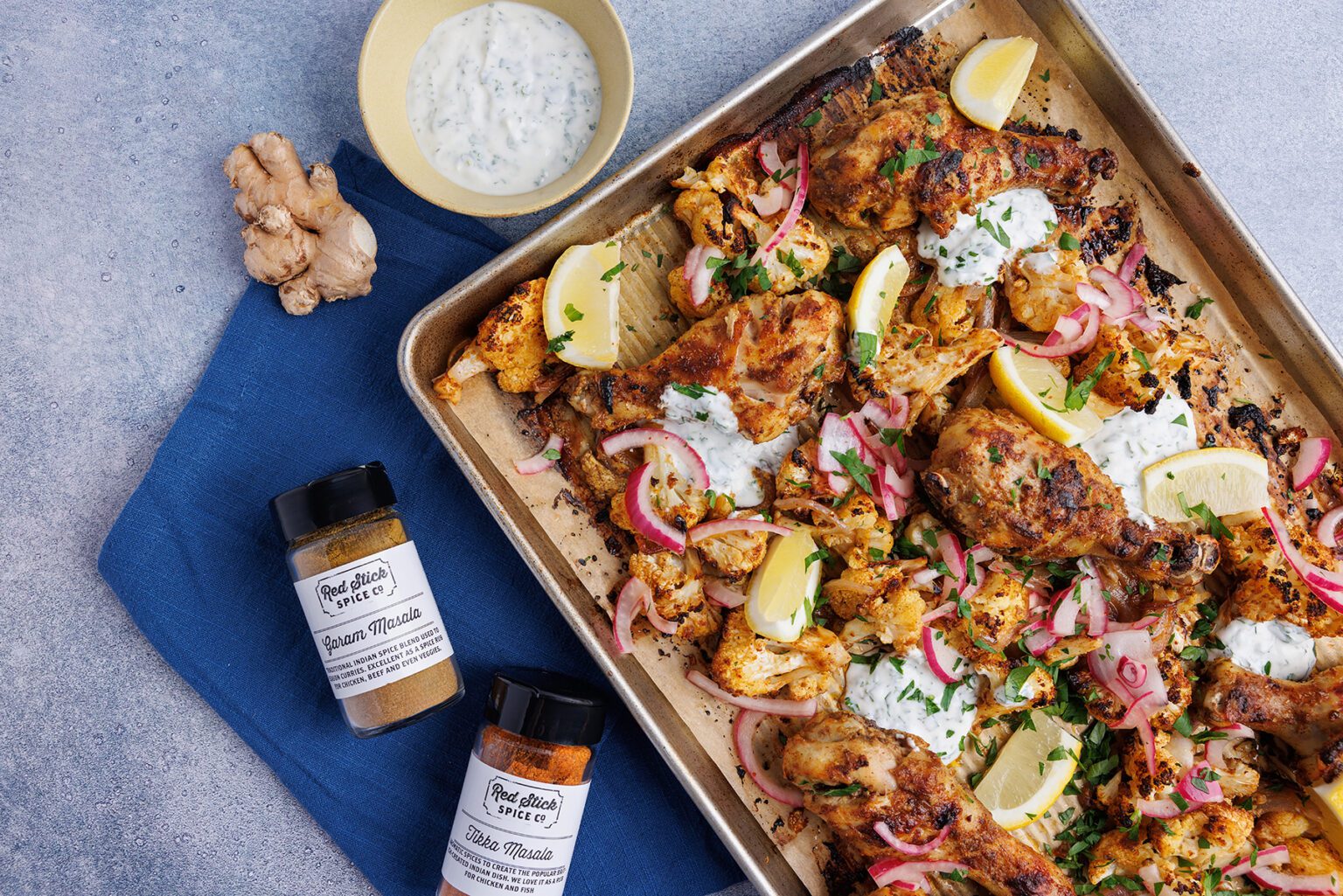
Ever wondered how to use wasabi powder? How about which type of cinnamon works best for baking? If you’ve ever faced flavor-confusion you’re not alone. With the large variety of herbs and spices on the market and in honor of National Spices and Herbs day, we’ve put together this quick guide covering the origins, uses and flavors of the most common and not-so-common spices and herbs to help you feel more confident in the kitchen.
A
Allspice – Allspice is indigenous to tropical Central America and the West Indies, but today, most allspice is cultivated in Jamaica and is one of the most important ingredients of Caribbean cuisine. Allspice is aptly named because it has the pleasant fragrances of cinnamon, clove, nutmeg and pepper — all the spices! Add Allspice to brines and poaching liquid.
Product to try: Seven Peppercorn Blend featuring Allspice
Annatto Seed – Annatto, also known as Achiote and Roucou, lends a slightly nutty, sweet and peppery flavor to dishes. Annatto is the major component in Achiote paste — a Latin cooking staple. Annatto lends a distinctive yellow amber color to recipes. It’s often referred to as “poor man’s saffron” because its color is similar to the expensive threads.
B
Balinese Long Pepper – Once prized by the ancient Romans, the Balinese Long Pepper was long forgotten about due to the rise in popularity of the peppercorn. The Balinese Long Pepper has a unique, earthy flavor with a spicy kick and a floral hint. With traces of cinnamon, cardamom and nutmeg, the Balinese Long Pepper can be used in a variety of dishes.
Basil – Basil has been cultivated for more than 5,000 years and is considered the “king of herbs” by many cookery authors. The ground herb is characterized by a warm, sweet, and highly aromatic flavor. Use in Italian red sauces, on grilled fish, roasted chicken, or in soups.
Recipe to Try: Lemon Basil Butter Cookies
Bay Leaf – Dried bay leaves are used in cooking for their distinctive flavor and fragrance. The leaves are not meant to be eaten although you can. Bay Leaves add a tangy, earthy flavor to long-simmering dishes like gumbo, etouffee and red beans.
Recipe to Try: Colombian Beef Stew with Sweet Potatoes
C
Caraway Seed – The use of caraway goes back to the Stone Age. The Black Caraway Seed is smaller than traditional caraway and has more of an intense flavor. The fruits, usually used whole, have a pungent, anise-like flavor and aroma. It’s a must in Austrian and German cooking and in many breads and pastries including English Seed Cake.
Cardamom – Cardamom is native to India and has a fresh green color and pungent, aromatic flavor. Cardamom is found in curries, chai tea and many African and Asian spice mixes like Arabic Seven Spice and Chinese Five Spice. Cardamom is also used in Scandinavian sweet dishes, such as coffee cakes and pastries. Chewing on Cardamom Pods can calm an upset stomach while sweetening the breath. Ground Cardamom Seed is also found in many Moroccan Spice Blends like our Ras El Hanout.
Recipe to Try: Classic Creme Brulee with Cardamom Whipped Cream
Celery Seed – These tiny seeds from the head of the celery plant are packed full of flavor. Use them wherever celery is called for but use sparingly. Celery seed is often found in recipes for long-cooking braised dishes like soups and stews. Grind these with salt to make the perfect rimming salt for Bloody Marys.
Recipe to Try: Mesquite Pulled Chicken with Alabama Sauce
Chervil Leaf – Chervil is one of the first herbs to emerge after winter. It’s similar to parsley but more feathery with a flavor reminiscent of anise. Chervil is one of the four traditional French fines herbes, along with tarragon, chives, and parsley, which are essential to French cooking. Chervil is often used for flavoring cream based soups, egg dishes and smoked fish.
Chives – Chives are bright green, long, hollow, thin leaves from the onion family. Chives have a delicate onion flavor and are considered an essential ingredient in French cooking.
Cinnamon – Ceylon Cinnamon is ground from the bark of the Cinnamon tree and is the only “true” cinnamon. When in stick form, Ceylon is softer and easier to crumble. Ceylon Cinnamon is less spicy and lighter in color than Vietnamese or Korintje Cassia. It’s flavor is more subtle making it a good choice for spice blends and Asian cooking. Vietnamese Cinnamon, however, is prized for its intense flavor among bakers, while Korintje Cinnamon, a milder cinnamon, is a less potent choice for baking. Korintje Cassia cinnamon is the most widely available cinnamon in the United States.
Recipe to Try: Banana Bread with Cinnamon Sugar Crunch Topping
Cloves – Cloves are native to the Maluku Islands in Indonesia, but are commercially harvested in Indonesia, India, Madagascar, Zanzibar, Pakistan, Sri Lanka and Tanzania. Cloves date back to the spice trade. The exotic flavor and aroma of cloves provide an interesting undertone to beef stews, marinades, spice cakes and gingerbread.
Recipe to Try: Honeycrisp Apple Sangria
Coriander Seed – Coriander is an annual herb with a very long culinary history. All parts of the coriander plant are used in cooking. The leaves, known as cilantro, are used in Latin dishes. The root is found in many Thai dishes. And the seed is a fragrant addition to many spice blends and European dishes. It’s also a common ingredient in Indian spice blends and is often used in Middle Eastern lamb and beef stews.
Cumin – Cumin is the seed of a small annual herb and has been in use since ancient times. Cumin is the distinct flavor in many Latin and Indian dishes. Whole Cumin Seed is an important component in Indian spice mixtures, Mexican dishes and Southwestern “Tex Mex” cuisine. Use in curry blends, salsa, couscous and black bean soup.
Recipe to Try: Simple & Delicious Marsoor Dal
D
Dill – Widely used in European dishes, Dill Seeds are similar in taste to Caraway Seeds. Dill seeds are often used as a rub for meats, in sour cream sauces, in pickling mixtures and in many soups, stews and sauces. Dried dill leaves or “dill weed” are widely used as herbs in Europe and central Asia. Dill weed is a lovely aromatic addition to many dishes.
Recipe to Try: Greek Chicken Skewers with Tzaziki
F
Fennel Seed – Fennel is a flowering perennial that produces seeds used as a cooking spice. Fennel’s use dates back to medieval Europe. Because of its licorice-type flavor, Fennel Seeds were (and still are) used as a breath freshener. They are often used in breads, cakes, cookies and hot drinks, such as spiced tea. Fennel is also used to flavor butter, cheese spreads and salad dressings. Use it on game meat, or add it to cabbage, beets, pickles, lentils and potatoes.
Fenugreek Seed – Fenugreek is a sturdy annual that is native to South Asia and Southeastern Europe. Fenugreek Seeds are a deep golden color with a smooth, hard surface and an angular shape. The Latin meaning of Fenugreek is “Greek Hay” and it’s believed to have been used in dishes from the Mediterranean region, although the spice is primarily associated with Indian cuisine. The seeds must be dry roasted prior to use or they will have a bitter flavor. Fenugreek Seeds are wonderful when sprouted and used in salads. The seeds can also be soaked and cooked like any legume.
G
Ginger – Ginger is the root of a plant cultivated all over Asia. It has a long history in European baking, and has a hot and spicy flavor that’s both refreshing and sharp. Ginger is known for its ability to sooth a troubled tummy. Ginger is second only to salt in importance for Asian cuisines. Use Powdered Ginger Root in gingerbread, gingersnaps and other sweet snacks, or add ginger to Indian spice blends like Garam Masala, Chinese stir fry, marinades and stews.
Recipe to Try: Soft and Sugary Ginger Cookies
Gumbo File – Gumbo File is a seasoning made from the ground, dried leaves of the Sassafras Tree. This seasoning is an integral part of Creole cooking used to flavor and thicken gumbos and other Creole dishes. This powder has a woodsy flavor, almost reminding us of root beer. Sprinkle over gumbo as a seasoning and thickening agent. Gumbo File powder adds a distinctive, earthy flavor and texture.
L
Lavender Flowers – Lavender is well-known for its strong fragrance, but it adds a delicate flavor to vinaigrettes and marinades. The buds contain the essential oil of lavender, from which the scent and flavor of lavender are derived. Use it in baking by sprinkling over frosted sugar cookies or buttercream iced cakes for a sophisticated touch. Rub lavender on chicken before roasting for a delicious flavor.
M
Marjoram Leaf – Marjoram is a perennial herb that’s commonly used in French and Italian cooking. Marjoram is indigenous to the Mediterranean area and was known to the Greeks and Romans, who looked on it as a symbol of happiness. Marjoram has a delicate, sweet and pleasant flavor with a slightly bitter undertone and can be used as a flavoring for meat dishes. Marjoram is a delicious seasoning for tomato-based sauces, olive oil and vinegar salad dressings with anchovies.
Mustard Seeds – Mustard has long been used in culinary creations. It’s mentioned in the Bible and was used by both the Romans and the Greeks. In the Middle Ages, ground mustard seeds were added to wine to make an early version of table mustard. White Mustard bears large yellowish seeds that have a mild flavor. This is the Mustard seed that’s used extensively in the production of American Mustards. Use it to make Vinaigrette Dressings, Marinades, Pickles and Chutneys.
Recipe to Try: Turnips in Coconut & Mustard Seed Curry
N
Nutmeg – Nutmeg is native to the Spice Islands and comes from inside of the fruit of the Evergreen Tree. It has a long history of being used in Asian cooking. To avoid cooking out its flavor, add nutmeg at the end of cooking. Use it in puddings, eggnogs, spiced wine, and baked goods such as muffins and apple pie. It’s also wonderful in savory dishes like pasta, sauces, and steamed vegetables.
Recipe to Try: Crispy Top Mac and Cheese
O
Oregano – Oregano is another herb that comes from the Mediterranean region and is related to the herb Marjoram, but has a stronger, more pungent flavor and aroma. The name Oregano is Greek in origin and means Joy of the Mountain. Oregano was long used as a soothing compound for sore muscles. Use in tomato sauces, soups, herbed breads, meat rubs or stews. The Mexican variety is generally used in highly spiced dishes because of its characteristically pungent flavor.
Recipe to Try: Cilantro and Lime Chicken Chili
P
Papaya Powder – The enzymes in Papayas make this powder a superior meat tenderizer. Use this on tough cuts of beef and pork to yield tender meat at the end of the cooking process. Simply rub the meat with the papaya powder and allow to sit for at least an hour. Season and cook as usual. Imparts a slight sweetness that’s a great addition to many spice blends.
Parsley – Parsley is native to the central Mediterranean region and is widely cultivated as a herb, a spice, and a vegetable. Parsley is the universal garnish and is widely used in Middle Eastern, European, Brazilian and American cooking. In southern and central Europe, parsley is part of Bouquet Garni, a bundle of fresh herbs used as an ingredient in traditional French stocks, soups, and sauces. Stir dried parsley flakes into pastas or any kind of sauce to add some bright green flair or the perfect finishing touch.
Poppy Seeds – Poppy Seeds are native to the Middle East. They are tiny, nutty flavored, blue-gray seeds. and are often added to cookies, cakes, breads and muffins to add a nutty flavor and texture. They’re high in calcium, magnesium and fiber. When ground, they add an almost fruity flavor to baked goods. Try this in your next cake batter.
Recipe to Try: Customized Buns & Rolls
R
Rosemary – Rosemary is native to the Mediterranean region and in Latin means “Dew of the Sea.” The plant resembles an Evergreen, with long, needle shaped leaves and small light blue flowers. In Italian cooking rosemary is often used to season meat dishes and some types of tomato sauce and breads. Rosemary is an essential ingredient when cooking a leg of lamb. You can use Rosemary leaf whole, cracked or ground.
Recipe to Try: Rosemary Roasted Pecans
S
Saffron Threads – Saffron is the most expensive spice in the world due to its harvesting process. Saffron comes from a crocus flower. The female pistil has 3 components, the stigma, style and ovary. The pistil has one style that branches into three distinct stigmas. These three stigmas are the Saffron threads. Each crocus flower produces only 3 threads, and it takes over 200,000 stigmas to make 1 pound of threads. The threads are deep red and bright orange in color, are about 1 inch long and have the taste of bitter almonds. Saffron is used to flavor dishes and as a dye. Saffron’s flavor compliments light meats, fish and poultry and is frequently used to season Pilaf, Italian Risotto and Mexican rice. For best results with flavor and color, grind the threads prior to use.
Recipe to Try: Easy Weeknight Paella
Sage Leaf – Sage is native to the North Mediterranean region and has a long history of use. Historically, Sage was used more for its medicinal properties than for its flavoring properties. Greeks, Romans, Arabs and American Indians all used Sage for curing or worship. Use Sage to flavor various meat dishes including sausage, veal, poultry casseroles, stuffing for turkey and pheasant. Sage is also a delicious addition to roasted potatoes and vegetables such as eggplant and mushrooms.
Recipe to Try: Mushroom and Sage Roasted Brussels Sprouts
Savory Leaf – Savory is from the Mediterranean region and comes in two forms, an annual and a perennial. Whole leaf Savory is small and green with a very fragrant, slight peppery taste. Savory, like many herbs from this region, was used by the Romans and was often combined with Rosemary, Thyme, Sage, Fennel and Bay Leaves. Savory is wonderful when added to legumes, particularly lentils. The flavor of Savory is strong enough that no salt is needed for the beans. Savory is great in marinades and salad dressings. Rubbed on meat prior to cooking will allow Savory to enhance the flavor of any type of meat.
Sesame Seed – History suggests that the Sesame Seed is the first recorded seasoning, dating back to 3000 B.C. Assyria. It grows widely throughout the Orient and in India. Sesame Seeds were brought to America by African slaves, who referred to the seed as the Benne Seed. This seed soon became very popular with Southern cooking. These seeds are highly valued, being rich in protein and in polyunsaturated oil. Typically Sesame Seeds are pressed into oils or made into pastes to serve as flavoring agents or in sauces. These flat, tiny seeds have a rich, nutty, sweet flavor which allows them to be used in many different dishes.
Star Anise – Star Anise is obtained from the star-shaped pericarp of a medium-sized native evergreen tree of northeast Vietnam and southwest China. It is an important spice in Asian cooking, and is considered an essential ingredient in Chinese Five Spice Blend. Its distinct licorice flavor has become popular in baking through the use of Pure Anise Extract. Star Anise can be added to a recipe whole or ground. Use it in roasted chicken or duck, poached fish or light soups. This unique spice is also a great finishing touch to cocktails.
Sumac – Sumac is grown in the Middle East, and has traditionally been used in Middle Eastern dishes in the ways that lemon or vinegar would be used by Western cooks. Ground Sumac gives a sourness to dishes. Mix it with strained yogurt to make a wonderful light sauce. Sumac can be added to marinades, salad dressings or rubbed on meats before grilling.
Recipe to Try: Fattoush
T
Tarragon – Tarragon is native to Siberia but became common throughout Europe in the 1400’s. The Latin name means “Little Dragon,” and stems from the belief that Tarragon could heal snake bites.True, or French Tarragon, has a delicate Anise scent and is harder to locate because the majority of seeds never take root. A classic French herb, Tarragon is used in sauces such as bearnaise and hollandaise. Combine with dijon mustard, olive oil and white wine vinegar for a delicious salad dressing, or use Tarragon to season shrimp, chicken, vegetables and egg dishes.
Recipe to Try: Poulet A L’Estragon or Tarragon Chicken
Tellicherry Black Peppercorns – Peppercorns are one of the most commonly used spices, and account for 1/4 of all of the global spice trade. The berry of the Piper Nigrum plant, the peppercorn’s first documented use was in South Asia in the 4th century BCE. Black Peppercorns have a crisp and aromatic flavor, and are known to have the most robust flavor of all peppercorns.
Thyme – Thyme is an herb native to the Mediterranean and widely used in French cuisine. Thyme has a minty flavor and a hint of a lemony aroma. Use Ground Thyme to add flavor to vegetables, meat, fish, soup and cream sauces. You can find Thyme in the classic French blend, Bouquet Garni.
Turmeric – Turmeric root is in the Ginger family. The flesh is a bright orange and dries to a deep yellow-orange color. A staple in Indian cooking, Turmeric adds the familiar color to curry powders and garam masala. It’s a wonderful addition to soups, stews, bean dishes and tomato-based sauces. While turmeric’s use as a wellness product may be fairly recent news in the U.S., it’s been used this way for centuries throughout the world and is known for its anti-inflammatory properties.
Recipe to Try: Summer Peach Smoothie with Turmeric and Cinnamon
W
Wasabi Powder – Wasabi is a variety of green horseradish, and has a sharp flavor that’s known for being hotter than the familiar horseradish. A nice change from the spiciness of chiles, wasabi gives a punch of heat but then dissipates. Wasabi is traditionally used as a paste with sushi, but try using it as a flavoring in mustards, sauces, dips or sandwich spreads.
White Pepper – White Pepper comes from South Asia, where it has been used for centuries. Chefs use White Pepper in dishes where the sharp, spicy flavor of black pepper is desired, but the color is not. Use Ground White Pepper in white gravies, cream sauces, potato dishes and salad dressings.
Any spice or herb we didn’t cover that you’re interested in learning about? Let us know in the comments.






